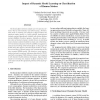Free Online Productivity Tools
i2Speak
i2Symbol
i2OCR
iTex2Img
iWeb2Print
iWeb2Shot
i2Type
iPdf2Split
iPdf2Merge
i2Bopomofo
i2Arabic
i2Style
i2Image
i2PDF
iLatex2Rtf
Sci2ools
100
click to vote
CVPR
2000
IEEE
2000
IEEE
Impact of Dynamic Model Learning on Classification of Human Motion
The human figure exhibits complex and rich dynamic behavior that is both nonlinear and time-varying. However, most work on tracking and analysis of figure motion has employed either generic or highly specific hand-tailored dynamic models superficially coupled with hidden Markov models (HMMs) of motion regimes. Recently, an alternative class of learned dynamic models known as switching linear dynamic systems (SLDSs) has been cast in the framework of dynamic Bayesian networks (DBNs) and applied to analysis and tracking of the human figure. In this paper we further study the impact of learned SLDS models on analysis and tracking of human motion and contrast them to the more common HMM models. We develop a novel approximate structured variational inference algorithm for SLDS, a globally convergent DBN inference scheme, and compare it with standard SLDS inference techniques. Experimental results on learning and analysis of figure dynamics from video data indicate the significant potential ...
Computer Vision | CVPR 2000 | Dynamic Bayesian Networks | Hand-tailored Dynamic Models | Human Figure Exhibits | SLDS Inference Techniques | SLDS Models |
Related Content
| Added | 12 Oct 2009 |
| Updated | 12 Oct 2009 |
| Type | Conference |
| Year | 2000 |
| Where | CVPR |
| Authors | Vladimir Pavlovic, James M. Rehg |
Comments (0)

